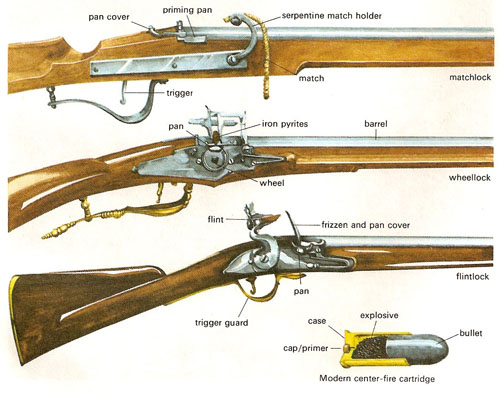early firearms: small arms

Early firearms adopted various firing mechanisms, of which three of the more significant are illustrated here. The development of the percussion lock and the center-fire cartridge in the 19th century represented an enormous improvement on all these designs and greatly increased the efficiency of firearms.
Firearms are weapons in which missiles are projected by firing explosive charges. They are classified as either artillery or small arms. The latter seem to have originated in fourteenth-century Europe in the form of metal tubes, closed at one end, into which gunpowder and the missile were packed, the charge being ignited via a touch hole. The heavy harquebus was one of these.
The 15th century saw the introduction of the matchlock in which a spring-loaded lever mechanism was used to introduce a smoldering match (a hemp cord soaked in saltpeter) to the powder. This was superceded by the wheel lock in the next century. In this a serrated wheel rotated against a flint and ignited the powder with a spark.
In the 17th century the flintlock was introduced. Here a flint held in a spring-loaded arm, or cock, struck a metal hammer, or frizzen, to produce the spark. The perfecting of the gas-tight breechblock and the modern percussion lock in the early nineteenth century led to the development of the breech-loading rifle and the repeating pistol.
By the end of the century, machine guns were in an advanced state of development. Shotguns, used mainly for sport, fore a cartridge containing numerous small pellets.
